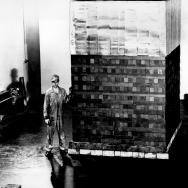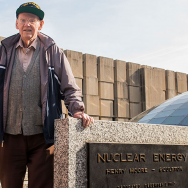In 1942, the Manhattan Project needed to create a chain reaction—a crucial step toward proving that it would be possible to make an atomic bomb. The scientists achieved this sustained nuclear reaction, the first created by humans, on Dec. 2, 1942, in a squash court under the stands of Stagg Field at the University of Chicago.
Nicknamed “Chicago Pile-1,” the world’s first nuclear reactor kicked off the Atomic Age and has a complicated legacy, including the rise of both nuclear energy and nuclear weapons.
Jump to a section:
- Why was the first nuclear reactor built?
- What did the first nuclear reactor look like?
- How did the first nuclear reactor work?
- What happened on the day of the first nuclear chain reaction?
- What happened to the reactor afterward?
- How did the reactor lead to the first atomic bomb?
- What was the legacy of the first nuclear reactor?
- Can you visit the site of the first nuclear reaction?
Why was the first nuclear reactor built?
As physicists came closer to understanding the nature of the atom in the 1930s, it became increasingly clear that a great deal of energy could be released by splitting atoms. In 1939, Albert Einstein and Leo Szilard co-wrote a letter to U.S. President Franklin D. Roosevelt, explaining that the discovery could be made into a powerful weapon, and that Nazi scientists likely had the tools to do so.
That kicked off the United States’ Manhattan Project, a top-secret scientific mission to learn how to split the atom and harness its power. But one of the first things on the list was to learn whether it was possible to create and control a nuclear chain reaction at all.
The Project decided to consolidate this effort in one location. Because Chicago had an existing population of top physicists and chemists, was centrally located far from both coasts, and had space and housing for the project, the nuclear reactor project was headquartered at the University of Chicago and code-named “the Metallurgical Laboratory.”
The Metallurgical Laboratory was led by Prof. Arthur Holly Compton, a Nobel laureate and dean of the physical sciences at UChicago, and included the most eminent physicists, chemists and engineers of the time—including Enrico Fermi, Leo Szilard and Eugene Wigner. Hundreds of people were recruited to “help the war effort,” though most were told very little about the details.
After a series of smaller experiments to prove the concept, work began on the reactor that would actually sustain the chain reaction. It was originally planned to be built west of the city of Chicago, but construction difficulties slowed up progress, so Compton decided they would go ahead and build the reactor where many of the experiments had taken place up to that point—an old squash court underneath the abandoned Stagg Field football stands at the University of Chicago.
It’s debated whether the president of the University of Chicago, Robert Maynard Hutchins, knew the experiment was going to take place, though Compton said he did not tell him. The mayor of Chicago and other elected officials were not notified.
What did the first nuclear reactor look like?
The reactor itself, nicknamed “Chicago Pile-1” or CP-1 for short, was a 20-foot-tall pile of graphite blocks studded with hundreds of smaller blocks of uranium.
Crews worked round the clock for two weeks, purifying graphite and uranium, arranging the blocks in 57 layers of precise positions, and fitting holes for cadmium control rods. They finished on the evening of Dec. 1, 1942.
How did the first nuclear reactor work?
A nuclear reactor is designed to split atoms. Some elements, like uranium, naturally throw off particles called neutrons as time goes by. The way a nuclear reactor works is by arranging uranium in just the right positions to encourage neutrons from uranium to hit other uranium atoms and cause them to split and throw off more neutrons, which split other atoms. This is why it’s called a chain reaction. But everything has to be positioned at just the right angles to keep the reaction going.
Engineers can control the reaction by inserting rods made out of a substance that absorbs neutrons, which slows or stops the chain reaction.
What happened on the day of the first chain reaction?
On Dec. 2, 1942, a group of 49 scientists gathered to conduct the criticality test. According to those who were there, it was a slow and quiet process: Fermi directed the operators to slowly move the control rods, and their instruments clicked to record the neutron count.
At 3:53 p.m., they recorded that a self-sustaining nuclear chain reaction was achieved for the first time ever. It had taken 28 minutes.
To celebrate, they drank Chianti wine out of paper cups. Many of those present signed the straw wrapper of the empty bottle.
What happened to the reactor afterward?
After the experiment, the reactor was disassembled and transported to a more remote location in a forest preserve outside Chicago. After the war, scientists and equipment from the Metallurgical Laboratory were reorganized and directed to begin investigating peaceful uses of atomic energy, becoming the nation’s first national lab—Argonne National Laboratory.
How did the reactor lead to the first atomic bomb?
In order to build an atomic bomb, the Manhattan Project first needed to prove that a chain reaction would actually work the way they thought it would.
Second, they needed to build more and larger reactors in order to create the right kind of plutonium and uranium to use in atomic bombs. Toward that end, the Manhattan Project dismantled Chicago Pile-1 and rapidly moved to build larger reactors at Hanford, Washington and Oak Ridge, Tennessee to produce uranium and plutonium. The main scientific leadership moved to Los Alamos, New Mexico, where they assembled and tested the bombs.
The U.S. ultimately dropped two atomic bombs on Japan: Hiroshima on Aug. 6, 1945 and Nagasaki on Aug. 9. It’s thought that more than 200,000 people died in the two blasts.
What was the legacy of the first nuclear reactor?
Though the experiment itself was short-lived, Chicago Pile-1 had complex, long-lasting effects around the world.
Nuclear weapons reshaped global politics and alliances; nuclear energy now produces 10 percent of the world’s electricity; and new fields of inquiry were opened as researchers used radioactive isotopes to treat disease and understand how the body works.
- Nuclear weapons: In the years after the Manhattan Project, the U.S. and Soviet Union spent billions of dollars building thousands of nuclear bombs. At the peak, in 1986, there were estimated to be about 70,000 atomic weapons in six nations around the world. About 500 bombs were detonated above-ground for tests before they were moved underground by treaty in 1963. Nuclear weapons continue to heavily influence global politics and alliances; as of 2025, there are thought to be about 12,000 remaining in the world.
- Doomsday Clock and Bulletin of Atomic Scientists: A group of scientists from the Manhattan Project who objected to the use of the bomb on human beings went on to form the Bulletin of Atomic Scientists, which sets the Doomsday Clock countdown to midnight as a metaphor for how close humanity is to destruction at its own hand. Today it has grown to incorporate climate change and biological threats, among others, into its calculus.
- Nuclear energy: The other immediate use for nuclear reactors was to produce electricity. The U.S. government quickly set up national laboratories to develop nuclear reactors for energy. A reactor built by Argonne National Laboratory produced the world’s first usable amount of electricity from nuclear energy on Dec. 20, 1951, lighting a string of four light bulbs. Today, about 20% of the electricity in the U.S. is produced by nuclear reactors, and 10% worldwide. Though the development of new nuclear reactors in the United States slowed in the late 20th century, nuclear power has recently become of greater interest as a source of carbon-free electricity.
- Chemistry and biology: The rise of nuclear reactors helped researchers to understand chemistry and biology, to create new kinds of materials, and to treat human diseases. Reactors can produce radioactive isotopes, which scientists used as tracers to understand metabolism, how nutrients move through ecosystems, and how cells make DNA, among others. Reactors also produce neutrons, which scientists can use as an imaging technique to see at the smallest scales.
- Science policy: Chicago Pile-1 and the Manhattan Project marked the beginning of a sea change in how science was conducted. After the war, funding for scientific research and development in the U.S. began to come primarily from the federal government, through the National Science Foundation and Department of Energy, rather than individual philanthropic donors. It also laid the foundations for large collaborations, like the Large Hadron Collider, LIGO and NASA, that make up much of scientific research spending today.
- Medicine: In addition to discoveries about the fundamental nature of biology, researchers also immediately saw benefits for medicine. In the early 1950s, the Atomic Energy Commission funded the Argonne Cancer Research Hospital (which became the Franklin McLean Institute at the University of Chicago in 1973). The hospital successfully pioneered the use of radiation in cancer treatment, with efforts later expanding to include radiological innovations in the diagnosis and treatment of other diseases. The isotope technetium-99 is used in millions of procedures every year.
Can you visit the site of the first nuclear reaction?
The reactor was dismantled shortly after the Chicago Pile-1 experiments and moved west of the city. The squash court and old football stands that had housed it were demolished decades ago and replaced by the University of Chicago’s Joseph E. Regenstein Library and the Joe and Rika Mansueto Library. (People sometimes ask if there is any remaining risk of radioactivity, but the site was extensively tested, and no traces remain.)
However, a bronze sculpture by noted artist Henry Moore called “Nuclear Energy” and a plaque commemorate the spot and are open to visitors. The sculpture is located on the east side of Ellis Avenue between 56th and 57th streets, just south of the Max Palevsky residence hall and north of the glass dome of Mansueto Library.
In his remarks about the piece, which was dedicated on the 25th anniversary of the reaction on Dec. 2, 1967, Moore said he intended to evoke images of the human skull, mushroom clouds and a cathedral. “Like anything that is powerful, it has a power for good and evil ... the lower part [of the sculpture] is more architectural and in my mind has the kind of interior of a cathedral with sort of a hopefulness for mankind,” he said. (More details about “Nuclear Energy” are available at the University’s Arts website.)
Last reviewed December 2025.



